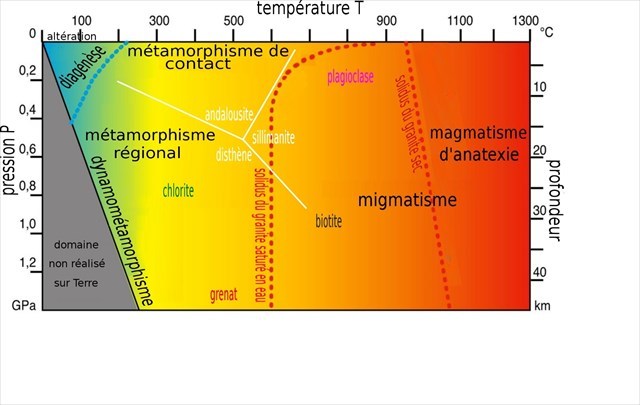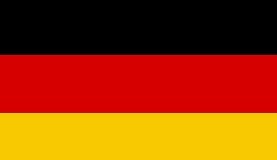Aux coordonnées, vous pouvez voir un affleurement d'ardoise argileuse. Elle est caractérisée par une quartzite principale avec des couches contenant du cuivre et du manganèse.
Le Massif armoricain est un complexe de fuselage et de sous-sol paléozoïque du nord-ouest de la France. Il occupe toute la Bretagne.

En raison du développement des montagnes au Carbonifère il y a environ 300 millions d'années, certaines roches déposées au Dévonien inférieur (il y a environ 410 millions d'années) comme fond marin près de l'équateur apparaissent sur le flanc nord. Le grès et l'ardoise argileuse sont particulièrement remarquables ici. Nous voulons examiner de plus près l'ardoise d'argile.
L'ardoise est un terme collectif pour désigner différentes roches sédimentaires tectoniquement déformées (plissées) et partiellement métamorphiques. Les ardoises argileuses, par contre, sont des roches de la zone de transition entre la diagenèse et la métamorphose.
Mais comment l'ardoise devient-elle de l'ardoise argileuse ?
Une ardoise passe par plusieurs étapes au cours de sa formation. Les premières boues argileuses se déposent en mer. Ces boues argileuses sont constituées de débris altérés par les intempéries, qui sont transportés par le vent et les rivières du continent à la mer, puis déposés en fines couches.
Lors du dépôt, des épaisseurs allant jusqu'à plusieurs milliers de mètres peuvent être atteintes, de sorte que la pression de superposition augmente et que la boue argileuse est transformée en une pierre argileuse par compactage. La pierre argileuse se fend après la stratification qui en résulte, si finement formée qu'elle ressemble à une schistosité. Les caractéristiques de stratification telles que les structures et les couleurs sont clairement visibles et augmentent l'attrait de ces ardoises. Au cours des processus de formation des montagnes, la pierre argileuse est exposée à une pression latérale et à des températures plus élevées. Il est transformé en ardoise argileuse et l'ardoise proprement dite est formée. L'inclinaison éclipse la stratification et l'ardoise ne se fend qu'après l'inclinaison. La stratification et la schistosité prennent un angle.
Les ardoises argileuses sont donc des roches clastiques denses de la zone de transition de la diagenèse à la métamorphose, de couleur noire, gris noirâtre, gris bleuté, mais aussi verdâtre, jaunâtre, rouge et violet, qui présentent une étroite schistosité de l'ordre du millimètre. Ces pierres peuvent être affectées aussi bien aux sédiments qu'aux métamorphites. La pierre elle-même ne présente pas encore les minéraux typiques nouvellement formés pendant la métamorphose. Pendant la formation rocheuse, les couches de blocs d'argile sont dépliées par pression latérale. Au cours de ces processus tectoniques, les surfaces de solution sont d'abord créées perpendiculairement à la pression dominante. De nouveaux minéraux argileux se cristallisent sur les surfaces, donnant à la pierre d'argile originale sa structure d'ardoise.
Apparence et propriétés
En plus des minéraux argileux, le stock minéral comprend également du quartz et des minéraux colorants tels que le chlorite (vert), l'hématite (rouge), la limonite (brun) ou le bituma (noir). De plus, les surfaces en ardoise des ardoises bitumineuses sont hydrophobes (hydrofuges).
 >
>
Processus géologique
Diagenèse (on parle ici de la solidification des sédiments à des pressions et températures relativement basses) à métamorphose (on parle ici de la solidification des sédiments à des pressions et températures élevées).

Es roches sédimentaires sont classées selon leur granulométrie :
Jusqu'à 0,063 mm : argile (non solidifiée), pierre d'argile ou argile d'ardoise (solidifiée), ardoise d'argile (métamorphique surpressée
0,063 à 2 mm : sable (non collé), grès (collé), quartzite (surgonflé métamorphiquement)
2 à 63 mm : gravier (non collé), conglomérat ou brèche (collé). Brèches angulaires, conglomérat composants arrondis
Traduit avec www.DeepL.com/Translator
Translation via DeepL / Sources : www.wikipedia.de / www.nagra.ch / www.steine-und-mineralien.de
"Loguez cette cache "Found it" et envoyez-moi vos propositions de réponses soit via mon profil, soit via la messagerie geocaching.com (Message Center), et je vous contacterai en cas de problème.
1. décrire la structure ou la nature de l'ardoise argileuse. Sous quel angle les couches d'ardoise sont-elles inclinées ? (mesure sur site)
2. quelle autre couleur peut être principalement observée dans les fragments d'ardoise à côté du gris ardoise (à voir sur place) ? Selon vous, quel matériau est responsable de cette coloration ?
3ème GRATUIT - Je serais heureux si vous joignez une photo de vous-même ou de votre GPS à votre entrée de journal.

At the coordinates, you can see an outcrop of clay slate. It is characterized by a main quartzite with layers containing copper and manganese.
The Armorican Massif is a Paleozoic fuselage and subsoil complex in northwestern France. It occupies all of Brittany.
Due to the development of Carboniferous mountains about 300 million years ago, some rocks deposited in the Lower Devonian (about 410 million years ago) as seabed near the equator appear on the northern flank. Sandstone and clay slate are particularly noteworthy here. We want to take a closer look at the clay slate.
Slate is a collective term for various tectonically deformed (folded) and partially metamorphic sedimentary rocks. Clay slates, on the other hand, are rocks in the transition zone between diagenesis and metamorphosis.
But how does slate become clay slate?
A slate goes through several stages during its formation. The first clayey sludge settles at sea. This clayey sludge is made up of debris altered by bad weather, which is transported by wind and rivers from the mainland to the sea, then deposited in thin layers.
During deposition, thicknesses of up to several thousand metres can be reached, so that the superposition pressure increases and the clay sludge is transformed into a clay stone by compaction. The clay stone splits after the resulting stratification, so finely formed that it resembles a schistosity. The stratification characteristics such as structures and colours are clearly visible and increase the attractiveness of these slates. During mountain building processes, clay stone is exposed to lateral pressure and higher temperatures. It is transformed into clay slate and the actual slate is formed. The inclination eclipses the stratification and the slate only splits after the inclination. Stratification and schistosity take an angle.
Clay slates are therefore dense clastic rocks of the transition zone from diagenesis to metamorphosis, black, blackish grey, blackish grey, bluish grey, but also greenish, yellowish, red and purple, with a narrow schistosity of the order of one millimeter. These stones can be used for both sediments and metamorphites. The stone itself does not yet have the typical minerals newly formed during the metamorphosis. During rock formation, the layers of clay boulders are unfolded by lateral pressure. During these tectonic processes, solution surfaces are first created perpendicular to the dominant pressure. New clay minerals crystallize on the surfaces, giving the original clay stone its slate structure.
Appearance and properties
In addition to clay minerals, the mineral stock also includes quartz and colouring minerals such as chlorite (green), hematite (red), limonite (brown) or bituma (black). In addition, the slate surfaces of bituminous slates are hydrophobic (water-repellent).
Geological process
Diagenesis (here we are talking about the solidification of sediments at relatively low pressures and temperatures) to metamorphosis (here we are talking about the solidification of sediments at high pressures and temperatures).
Sedimentary rocks are classified according to their granulometry:
Up to 0.063 mm: clay (unsolidified), clay stone or slate clay (solidified), clay slate (overpressed metamorphic)
0.063 to 2 mm: sand (not glued), sandstone (glued), quartzite (metamorphic overflow
2 to 63 mm: gravel (not glued), conglomerate or breccia (glued). Angular gaps, rounded component conglomerate
Translated with www.DeepL.com/Translator Translation via DeepL / Sources: www.wikipedia.de / www.nagra.ch / www.steine-und-mineralien.de
To register this EarthCache, please answer the following questions by email. You don't have to wait for a log to come out, I'll tell you back if something's wrong.
1. describe the structure or nature of the clay slate. At what angle are the slate layers inclined? (on-site measurement)
2. what other colour can be observed mainly in the slate fragments next to the slate grey (to be seen on site)? In your opinion, what material is responsible for this staining?
3. Optional - I would be happy if you include a picture of yourself or your GPS with your journal entry.

An den Koordinaten könnt ihr einen Tonschiefer-Aufschluss betrachten. Dieser wird durch Hauptquarzit mit kupfer- und manganhaltigen Schichten gekennzeichnet.
Das Armorican Massif ist ein paläozoischer Rumpf- und Grundgebirgskomplex im Nordwesten Frankreichs. Es nimmt die ganze Bretagne ein.
Durch die Auffaltung des Gebirges in der Karbonzeit vor etwa 300 Millionen Jahren, treten hier an der Nordflanke einige im Unterdevon (vor etwa 410 Millionen Jahren) abgelagerte Gesteine als äquatornaher Meeresboden zu Tage. Besonders hervorzuheben sind hier Sandstein und Tonschiefer. Mit dem Tonschiefer wollen wir uns näher beschäftigen.
Schiefer ist ein Sammelbegriff für verschiedene tektonisch verformte (gefaltete) und teilweise metamorphe Sedimentgesteine. Tonschiefer hingegen sind Gesteine in der Übergangszone zwischen Diagenese und Metamorphose.
Aber wie wird aus Schiefer Tonschiefer?
Ein Schiefer durchläuft während seiner Entstehung mehrere Phasen. Als erstes lagert sich Tonschlamm im Meer ab. Das Material für diesen Tonschlamm ist Verwitterungsschutt, der durch Wind und Flüsse vom kontinentalen Festland zum Meer transportiert und anschließend in feinen Schichten abgelagert wird.
Während der Deposition können Dicken von bis zu mehreren tausend Metern erreicht werden, so dass der Überlagerungsdruck zunimmt und der Tonschlamm durch Verdichtung in ein Tonstein umgewandelt wird. Der Tongestein spaltet sich nach der daraus resultierenden Schichtung, so fein geformt, dass er einer Schieferung ähnelt. Die Schichteigenschaften wie Strukturen und Farben sind deutlich sichtbar und erhöhen die Attraktivität dieser Schiefer. Bei Gebirgsbauprozessen wird das Tonstein dem Seitendruck und höheren Temperaturen ausgesetzt. Es wird in Tonschiefer umgewandelt und der eigentliche Schiefer wird gebildet. Die Neigung verdrängt die Schichtung und der Schiefer spaltet sich erst nach der Neigung. Schichtung und Schieferung nehmen einen Winkel ein.
Tonschiefer sind daher dichte klastische Gesteine der Übergangszone von der Diagenese zur Metamorphose, schwarz, schwarzgrau, schwarzgrau, schwarzgrau, blaugrau, aber auch grünlich, gelblich, rot und lila, mit einer schmalen Schieferung im Bereich von einem Millimeter. Diese Steine können sowohl für Sedimente als auch für Metamorphite verwendet werden. Der Stein selbst hat noch nicht die typischen Mineralien, die während der Metamorphose neu gebildet wurden. Während der Felsformation werden die Schichten von Tonfelsen durch seitlichen Druck aufgefaltet. Bei diesen tektonischen Prozessen werden zunächst Lösungsoberflächen senkrecht zum dominanten Druck erzeugt. Auf den Oberflächen kristallisieren neue Tonmineralien, die dem ursprünglichen Tonstein seine Schieferstruktur verleihen.
Aussehen und Eigenschaften
Zum Mineralbestand gehören neben Tonmineralien auch Quarz- und Farbminerale wie Chlorit (grün), Hämatit (rot), Limonit (braun) oder Bituma (schwarz). Darüber hinaus sind die Schieferoberflächen von bituminösen Schieferplatten hydrophob (wasserabweisend).
Geologischer Prozess
Diagenese (hier geht es um die Verfestigung von Sedimenten bei relativ niedrigen Drücken und Temperaturen) zur Metamorphose (hier geht es um die Verfestigung von Sedimenten bei hohen Drücken und Temperaturen).
Sedimentgesteine werden nach ihrer Granulometrie klassifiziert:
Bis zu 0,063 mm: Ton (unverfestigt), Tongestein oder Schieferton (verfestigt), Tonschiefer (überpresst metamorph)
0,063 bis 2 mm: Sand (nicht geklebt), Sandstein (geklebt), Quarzit (metamorpher Überlauf)
2 bis 63 mm: Kies (nicht verklebt), Konglomerat oder Brekzie (verklebt). Winkelspalte, abgerundetes Komponentenkonglomerat
Übersetzung über DeepL / Quellen: www.wikipedia.de / www.nagra.ch / www.steine-und-mineralien.de
Um diesen EarthCache zu loggen, beantworte bitte die folgenden Fragen per E-Mail. Auf eine Logfreigabe brauchst du nicht zu warten, ich melde mich, wenn etwas nicht stimmt.
1. Beschreibe die Struktur bzw. die Beschaffenheit des Tonschiefers. In welchem Winkel sind die Schieferschichten schräggestellt? (Vor-Ort-Messung)
2. Welche andere Farbe ist vor allem in den Schieferfragmenten neben dem Schiefergrau zu beobachten (vor Ort zu sehen)? Welches Material ist deiner Meinung nach für diese Färbung verantwortlich?
3. Optional - Ich würde mich freuen, wenn ihr eurem Logeintrag ein Bild von euch oder eurem GPS-Gerät beifügen würdet.